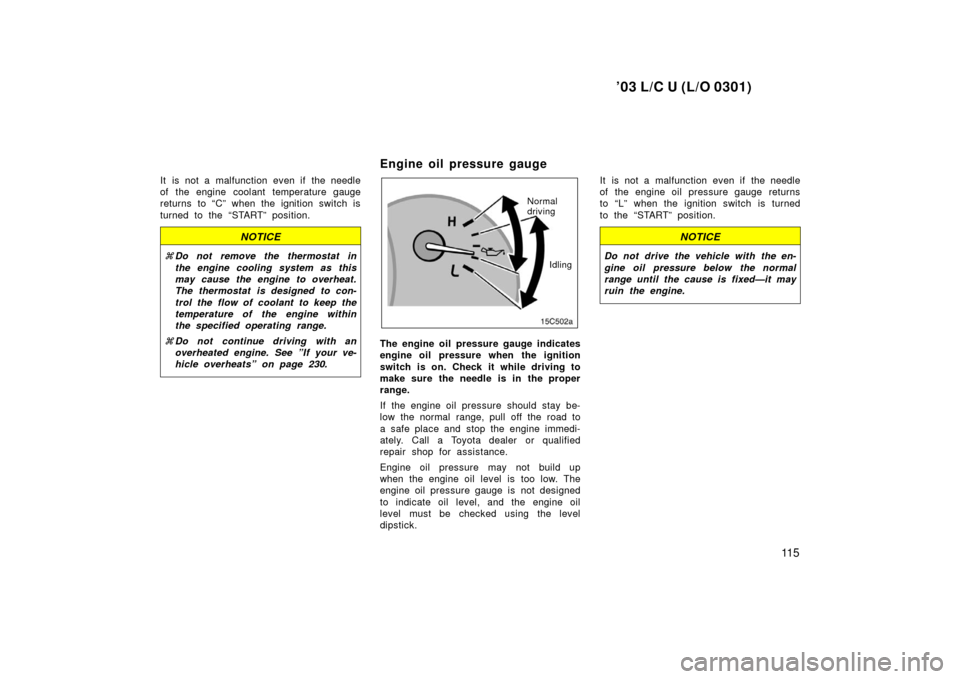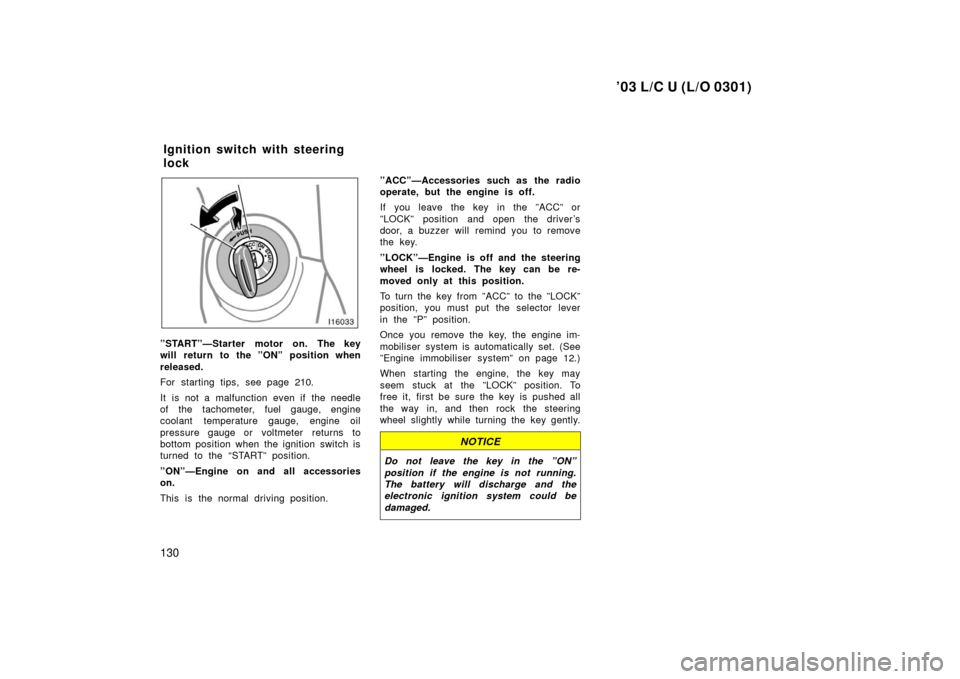Page 9 of 312
’03 L/C U (L/O 0301)
5
Instrument cluster overview
1. Voltmeter
2. Speedometer
3. Service reminder indicators and indicator lights 4. Tachometer
5. Engine oil pressure gauge
6. Engine coolant temperature gauge
7. Odometer and two trip meters
8. Trip meter reset knob
9. Fuel gauge
Page 10 of 312
’03 L/C U (L/O 0301)
6
Indicator symbols on the instrument panel
Brake system warning light∗1
Malfunction indicator lamp∗1
Headlight high beam indicator light Turn signal indicator lights
Driver ’s seat belt reminder light∗1
Anti�lock brake system warning light∗1
Open door warning light∗1
SRS warning light∗1
Low fuel level warning light∗1
Automatic transmission fluid temperature warning
light∗1
Unengaged ”Park” warning light∗1
Discharge warning light∗1
Engine oil replacement reminder light
Center differential lock indicator light Driving pattern (”POWER” mode) indicator
light
Automatic transmission second start indicator
light
Cruise control indicator light∗2
Automatic transmission indicator lights
Page 23 of 312
’03 L/C U (L/O 0301)
19
2. Remove the module from the keyframe.3. Remove the 2 screws to take out thelid of the module. Take out the dis-
charged battery and put a new battery
with the positive side up.
NOTICE
Do not bend the terminals.
4. Install the lid with the 2 screws.
5. Install the module into the key frameand secure the cover with the screw.
6. When pushing any switch on the wire- less key, make sure the indicator light
comes on.
NOTICE
�Make sure the positive side and
negative side of the battery are
faced correctly.
� Do not replace the battery with wet
hands. Water may cause unexpected
rust.
� Do not touch or move any compo-
nents inside of the transmitter, or
it may interfere with proper opera-
tion.
� Be careful not to bend the electrode
of the battery insertion and that
dust or oils do not adhere to the
case.
� Take care not to lose the screws.
� Close the cover securely.
Page 117 of 312
’03 L/C U (L/O 0301)
11 3
OPERATION OF INSTRUMENTS AND
CONTROLS
Gauges, Meters and Service reminder indicators
Fuel gauge11 4
. . . . . . . . . . . . . . . . . . . . . . . . . . . . . . . . . . . . .\
. . . . . . . . . . .
Engine coolant temperature gauge 11 4
. . . . . . . . . . . . . . . . . . . . . . . . . . .
Engine oil pressure gauge 11 5
. . . . . . . . . . . . . . . . . . . . . . . . . . . . . . . . . . .
Vo ltme te r 11 6
. . . . . . . . . . . . . . . . . . . . . . . . . . . . . . . . . . . . \
. . . . . . . . . . . . . .
Tachometer 11 6
. . . . . . . . . . . . . . . . . . . . . . . . . . . . . . . . . . . . \
. . . . . . . . . . . .
Odometer and two trip meters 11 7
. . . . . . . . . . . . . . . . . . . . . . . . . . . . . . . .
Service reminder indicators and warning buzzers 11 8
. . . . . . . . . . . . . .
Trip information display 125
. . . . . . . . . . . . . . . . . . . . . . . . . . . . . . . . . . . . \
. .
SECTION 1� 5
Page 119 of 312

’03 L/C U (L/O 0301)
11 5
It is not a malfunction even if the needle
of the engine coolant temperature gauge
returns to “C” when the ignition switch is
turned to the “START” position.
NOTICE
�Do not remove the thermostat in
the engine cooling system as this
may cause the engine to overheat.
The thermostat is designed to con-
trol the flow of coolant to keep the
temperature of the engine within
the specified operating range.
� Do not continue driving with an
overheated engine. See ”If your ve-
hicle overheats” on page 230.
Engine oil pressure gauge
Idling
Normal
driving
The engine oil pressure gauge indicates
engine oil pressure when the ignition
switch is on. Check it while driving to
make sure the needle is in the proper
range.
If the engine oil pressure should stay be-
low the normal range, pull off the road to
a safe place and stop the engine immedi-
ately. Call a Toyota dealer or qualified
repair shop for assistance.
Engine oil pressure may not build up
when the engine oil level is too low. The
engine oil pressure gauge is not designed
to indicate oil level, and the engine oil
level must be checked using the level
dipstick. It is not a malfunction even if the needle
of the engine oil pressure gauge returns
to “L” when the ignition switch is turned
to the “START” position.
NOTICE
Do not drive the vehicle with the en-
gine oil pressure below the normal
range until the cause is fixed—it may
ruin the engine.
Page 122 of 312
’03 L/C U (L/O 0301)
11 8
Service reminder indicators and warning buzzers
If the indicator or buzzer comes on...Do this.
(a)
(b)
(c)
(d)
(e)
(f)
(g)
(h)
(Indicator and buzzer)
(Indicator and buzzer) If parking brake is off, stop
immediately and contact Toyota dealer.
Fasten driver’s seat belt.
Fasten front passenger’s seat belt.
Stop and check.
Replace engine oil.
Take vehicle to Toyota dealer.
Fill up tank.
Take vehicle to Toyota dealer immediately.
Page 125 of 312

’03 L/C U (L/O 0301)
121
(b) Driver’s Seat Belt Reminder Lightand Buzzer
This light and buzzer remind you to
buckle up the driver’s seat belt.
Once the ignition key is turned to ”ON” or
”START”, the reminder light flashes and
the buzzer sounds if the driver ’s seat belt
is not fastened. Unless the driver fastens
the belt, the light keeps on flashing and
the buzzer sounds 4 to 8 seconds.
(c) Front Passenger ’s Seat Belt Re- minder Light
This light remind you to buckle up the
front passenger ’s seat belt.
Once the ignition key is turned to ”ON” or
”START”, the reminder light flashes if a
passenger sits in the front passenger seat
and does not fasten the seat belt. Unless
the front passenger fastens the belt, the
light stays flashing.
If luggage or other load is placed on the
front passenger seat, depending on its
weight and how it is placed on the seat,
built�in sensors in the seat cushion may
detect the pressure, causing the reminder
light to come on. (d) Discharge Warning Light
This light warns that the battery is being
discharged.
If it comes on while you are driving, there
is a problem somewhere in the charging
system.
The engine ignition will continue to oper-
ate, however, until the battery is dis-
charged. Turn off the air conditioning,
blower, radio, etc., and drive directly to
the nearest Toyota dealer or repair shop.
NOTICE
Do not continue driving if the engine
drive belt is broken or loose.
(e) Engine Oil Replacement Reminder
Light
This light reminds you when to replace
the engine oil.
This light will come on when the ignition
switch is turned to ”ON”, and will go off
after about a few seconds. When you drive for about 8000 km (5000
miles) after engine oil replacement, this
light illuminates for about 3 seconds and
then flashes for about 12 seconds with
the ignition key is turned to ”ON” position.
If you continue driving without engine oil
replacement, and if the driving range ex-
ceeds 12000 km (7500 miles), the light
will come on after the ignition key is
turned to ”ON” position. The light will re-
main on thereafter.
If the light is flashing, we recommend that
you replace the engine oil at an early
opportunity depending on the driving and
road condition. If the light comes on, re-
place it as soon as possible.
You need to reset the light after the en-
gine oil replacement. Reset the light by
following the procedure below:
1. Turn the ignition key to the ”OFF” posi- tion
with the odometer reading shown.
(For details, see “Odometer and trip me-
ter” on page 117).
2. Turn the ignition key to the ”ON” posi- tion while holding down the ”ODO/
TRIP” knob.
Hold down the knob until the light goes
off. Before the light goes off, it illuminates
for 3 seconds, flashes for 2 seconds, illu-
minates for 1 second.
Page 134 of 312

’03 L/C U (L/O 0301)
130
”START”—Starter motor on. The key
will return to the ”ON” position when
released.
For starting tips, see page 210.
It is not a malfunction even if the needle
of the tachometer, fuel gauge, engine
coolant temperature gauge, engine oil
pressure gauge or voltmeter returns to
bottom position when the ignition switch is
turned to the “START” position.
”ON”—Engine on and all accessories
on.
This is the normal driving position.”ACC”—Accessories such as the radio
operate, but the engine is off.
If you leave the key in the ”ACC” or
”LOCK” position and open the driver’s
door, a buzzer will remind you to remove
the key.
”LOCK”—Engine is off and the steering
wheel is locked. The key can be re-
moved only at this position.
To turn the key from ”ACC” to the ”LOCK”
position, you must put the selector lever
in the ”P” position.
Once you remove the key, the engine im-
mobiliser system is automatically set. (See
”Engine immobiliser system” on page 12.)
When starting the engine, the key may
seem stuck at the ”LOCK” position. To
free it, first be sure the key is pushed all
the way in, and then rock the steering
wheel slightly while turning the key gently.
NOTICE
Do not leave the key in the ”ON”
position if the engine is not running.
The battery will discharge and the
electronic ignition system could be
damaged.
Ignition switch with steering
lock